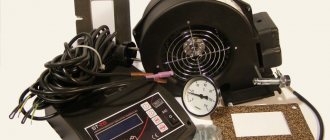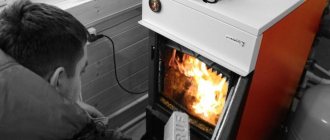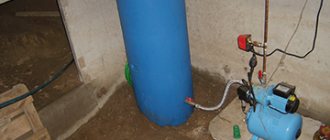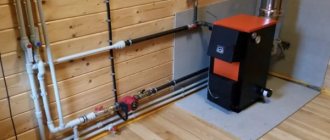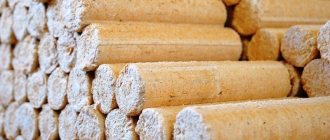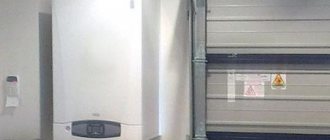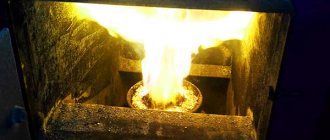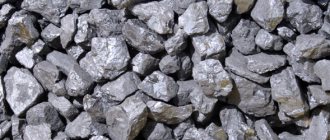What is cheaper to heat a house?
The cheaper it is to heat a house (gas, wood, electricity, coal, diesel)
| Type of fuel | Price per unit, rub. | Cost of heat received per 1 kWh, rub. |
| Eco-pea coal, kg. | 3 | 0,39 |
| Main gas, cubic meters | 5,04 | 0,54 |
| Dry pine firewood (20%), kg. | 3,9 | 0,99 |
| Air-to-water heat pump, kW.** | 1,1 | 1,10 |
Coal consumption for heating a house
The first calculation method is based on fact
.
We use the simplest “folk” container of weight and volume - a bucket. Coal is usually measured in tons, but it is unlikely that your boiler room will have scales to accurately weigh out the required dose for loading. One bucket holds approximately 18 kilograms of coal. To heat a house with an area of 200 square meters, approximately:
- September-October – 1 bucket per day;
- November-February – 10 buckets;
- March-April – 2 buckets.
Assuming in round numbers that there are 30 days in a month, we calculate the total number of buckets:
- September-October – 1x60=60;
- November-February – 10x60=600;
- March-April – 2x60=120.
- Total 60+600+120=780 buckets.
We convert the result into kilograms: 780x18 = 14,040 kilograms. That is, during the heating season, to heat a house of 200 square meters, a coal boiler for heating a private house is capable of burning a little more than 14 tons of coal. The second calculation method is pseudo-scientific
. Combustion of 200 grams of coal releases approximately 1 kW of heat. To comfortably survive the heating season, approximately 50,000 kW of heat is required. We multiply 50,000 by 0.2 - we get 10,000 kilograms or 10 tons.
What is the density of coal?
The density and porosity of coal depend on the petrographic composition, the amount and nature of mineral impurities and the degree of metamorphism. The components of the fusinite group are characterized by the highest density (1300-1500 kg/m³), the lowest (1280-1300 kg/m³) by the vitrinite group.
Interesting materials:
In what position should chicken eggs be stored? In what position should the pen be stored? What is the best position to store books? What solution should you store lenses in? In what form is information stored and processed on a computer? In what form is information stored in external memory? Why store eggs in the refrigerator? Why store onions in tights? What happens if you create a fake page? What should I do if Chrome itself opens pages with advertisements?
Which coal do you prefer?
A modern solid fuel boiler can operate normally on both coal and brown coal. However, if you have a choice, it is best to choose the highest quality coal - anthracite. This type of coal has the highest heat capacity and burns almost without a trace. True, it is somewhat more expensive than other varieties. You need to evaluate the cost of fuel, delivery and its heat capacity and choose the best option.
Don't forget about the fuel storage room. You can try to save on coal by choosing an inexpensive type. However, you will need a lot of it, so you will have to overpay for delivery, and also find storage space.
And vice versa - you will need less high-quality coal for heating, so you will save money on delivery and storage. This way you can significantly reduce the consumption of coal for heating your home. Read also: “How to heat a boiler with coal - theory and practice.”
Why is it beneficial to use coal?
The operation of modern solid fuel boilers does not cause any trouble. Especially if the homeowner prefers coal - an efficient, safe, convenient and cost-effective fuel. Compared to other types of the latter, it has many advantages:
- is characterized by high heat transfer, allowing to obtain much more heat per unit of heated area;
- not afraid of humidity;
- does not require special sealed containers for storage;
- It is sold in a convenient package in which it can be easily transported to a city home or to the country.
Installing a coal boiler allows you to not depend on the presence of a gas pipeline within reach, which is especially important for residents of the private sector. In addition, this type of heating equipment can be installed without special permission, which cannot be done, for example, by purchasing a gas boiler.
An additional benefit of using coal as a fuel is provided by the special design of modern boilers. Over the years, not only the appearance of the equipment has improved, but also the method of burning fuel, and, accordingly, its consumption.
Firstly, there was no longer a need to pour coal into the firebox several times a day and clean out the slag. Modern boilers have large combustion chambers and special safe bunkers for storing fuel, from which it is automatically supplied to the firebox via a conveyor as needed. You can immediately load as much coal into the chamber as is necessary for continuous operation of the system for 10-12 hours, and the volume of the bunker is designed for 6-7 days of constant burning of the boiler.
The combustion chambers in modern models of heating equipment are completely sealed and equipped with special ventilation systems, thanks to which the strength of coal combustion and the degree of heating of the system are adjusted. Due to the forced supply of the optimal volume of air, the fuel burns out almost completely, leaving behind a minimal amount of waste, which allows to significantly reduce its consumption.
How much coal is needed to heat a house? Coal heat supply, experience
Heating residential houses with coal is not a thing of the past, since the more preferable heating with gas is still not available in all regions and not to everyone, and, moreover, technological heating systems that run on coal are quite productive and the most balanced in quality and cost. Modern heating boilers for private buildings have been improved to such an extent that:
- they can burn a wide variety of fuels, including garbage;
- fuel consumption is several times less than in conventional stoves;
- due to the high temperature, the fuel burns almost without waste;
- do not require constant maintenance and are easy to use.
- what is the residential building made of?
- how insulated it is;
- what is the heated area;
- what type of heat supply is used;
- what kind of boiler is in operation;
- will be purchased;
- what are the average monthly outside air temperatures in this area;
- how long does the heating season last, etc.
The answers to all these questions determine how much coal is needed to heat a house, and what standards of coal consumption for heat supply should be applied.
For example, it is much easier to heat a wooden or block house than a brick house of similar size. Coal heating price
In both first cases it will be approximately a third less than in the last.
To supply heat to a well-insulated foam concrete house with an area of 100 square meters. m.,
As practice says, you will need 3 tons of coal (a third of it is coal, the rest is long-flame), and you can’t heat a poorly warm one with six tons.
In the south, a ton of coal is purchased for the entire heating season for a country house of 200 square meters. m., and in the northern regions, where frosts can sometimes reach 40 degrees, even a small wooden house with an area of 50 square meters. m.
over the winter it will “eat” three tons.
So coal consumption for home heating (
actually yours) will need to be done in a functional way. The very first. Of course, talk to your neighbors who have a home similar to yours to decide on the quantity in the most general terms: three or five tons will be needed, this is already a significant difference.
The trading organization will also guide you - they have a lot of experience. But you still don’t need to buy a decent amount of coal at once. Take, as they say, for testing, several bags of coal of different brands and try with it, remembering which one burns better, gives more heat, leaves a little ash and which one is most comfortable in the house.
You will most likely be conducting your own experiment in September, so make an adjustment for the outside air temperature. Having understood how many days the purchased volume lasted, you will be able to calculate the need for coal for the entire heating period.
In the first year, purchase fuel with a reserve; if there is any left, it will be useful next year; coal does not lose its qualities for a long time. It will be worse if there is not enough for the whole season.
For a more accurate calculation of coal consumption for home heating
(for example,
with an area of 150 sq. m.)
, you can listen to the advice of professionals. As is clear, to generate 1 kilowatt of heat energy, you will need to burn 0.2 kg of coal for an hour. For the heating period, this area requires approximately 40 thousand kW, or 8000 kg (40,000 x 0.2). In other words, you will have to purchase at least 8 tons of coal, which contains good heat output. You will need more brown, less coal.
An even clearer way to count is using a bucket. From many years of practice it is known that the heating supply of a house with an area of 150 sq. m approximately during the season, 450 buckets weighing 18 kilograms each are used. We multiply 450 x 18, we get 8100 kg, in other words the same 8 tons with less.
Having found out the quantitative need for fuel, and knowing the prices for it, it is easy to calculate how much it costs to supply coal with heat.
for the coming heating season
.
Nowadays, the need to use coal for heating very often appears when living outside the city limits in a non-gas supply house. In this case, coal is considered the most successful replacement, which is better than electric heating both in terms of costs and final efficiency.
This publication discusses coal heating. We will get acquainted with its theoretical and functional qualities, study the types of coal and give advice on its choice. Approximate fuel consumption in a variety of situations will also be given and equipment for heating a home will be demonstrated.
Coal for heating - varieties, tips for choosing
There are only 3 types of coal suitable for use in heating systems - coal (marked with the nomenclature “A”), brown (“B”) and hard coal, while hard coal, for its part, is divided into 5 varieties:
- long-flame - “D”;
- gas - “G”;
- skinny - “T”;
- coke - “K”;
- bold - "F".
Coal is considered the most widely used fuel in industry. It is better than other varieties in terms of consumption, heat transfer and combustion duration. Also, when burning coal, a minimal amount of slag waste is formed.
Anthracite contains 10% ash and 1% sulfur, therefore, during its combustion, the smallest volume of sulfur dioxide is released, which, upon contact with water, forms sulfuric acid - a substance that has a bad effect on the condition of metal structures (inner walls of boilers, chimney pipes).
However, it is impossible to offer coal for heating a home, because despite all the advantages, this material has major disadvantages. There are two of them - the highest cost and complexity of ignition among all types of coal.
What material should I choose? A suitable option for heating a house with coal is long-flame fuel - “DPK”; this type of coal is perfect for burning in solid fuel boilers, as well as for ordinary potbelly stoves, fireplaces and stoves. In terms of quality/cost ratio, “DPK” is considered an excellent option; it simply ignites, burns for a long time (does not require third-party blowing) and emits a relatively decent amount of heat energy.
Depending on the size of the fractions, “DPK” and other types of coal are classified into the following types:
- ordinary “P” - the size of the factions can be very different;
- seed “C” - fraction size 6-13 mm;
- pin “W” - up to 6 mm;
- small “M” - 13-25 mm;
- nut “O” - 26-40 mm;
- large “K” - 50-100 mm;
- slab “P” - more than 100 mm.
For domestic use, it is better to use fuel of classes “M” and “O”; the size of such fractions burns well both in layer and dust combustion.
1.1 Fuel consumption
Coal consumption is mainly calculated using standard 10-liter buckets (the usual capacity of a solid fuel boiler firebox); one bucket of this size contains 18 kg of material. According to average statistics, coal consumption for heating a house with an area of 200 m2 at different periods of the season is:
- September—October — 1 bucket/day;
- November—February - up to 10 buckets/day;
- March/April—1-2 buckets/day.
Having summed up the monthly consumption, we acquire total fuel consumption of the same 580 buckets, which is equal to 10.5 tons of coal. This figure is given without taking into account air temperature, so practical fuel consumption differs from region to region.
1.2 Pros and cons of coal heating, alternatives
Coal heating has the following advantages:
- the smallest cash expenses, frugality;
- availability of coal;
- ease of storage and transportation of the material (mainly supplied to the consumer in bags, coal briquettes for heating are also in demand);
- the ability to burn household waste simultaneously with fuel;
- autonomy - there is no need to connect outsiders to the house;
- low material consumption due to its high heat transfer.
But this method of heat supply also has its own disadvantages, which include:
- the need to continuously maintain the functionality of the system - you need to add fuel to the boiler or stove 2-3 times a day;
- the need for constant maintenance of the equipment - removing ash every 2 days, completely cleaning the firebox - once a week;
- When coal burns, dangerous gases are released, which, if the chimney system is poor, usually end up inside the house;
- burning coal has a distinctive, unpleasant aroma for most people.
As a replacement for coal as a material for heating a private home, you can consider fuel pellets - a granular material that consists of a mixture of peat and wood shavings. Fuel pellets are divided into two types - simple (white) and torrified (black).
Torrified fuel granules at the production stage are fired at a temperature of 300 degrees in vacuum chambers, which gives them a number of positive performance qualities. Such fuel pellets do not absorb moisture (they can be stored in damp rooms or under clear skies), do not rot and have a combustion efficiency comparable to coal, which is why black fuel pellets are often called bio-coal.
Fuel pellets are environmentally friendly fuel, in which the ash content will not exceed 3%. However, in terms of material costs, heating with simple “WPC” coal is more profitable, since its price will be approximately 5 thousand per ton, while the cost of pressed fuel pellets starts from 6.5 thousand, while the consumption of materials is almost the same.
1.3 How to choose a coal heating boiler? (video)
Choosing coal as a fuel and a boiler for it
Unfortunately, sometimes there are errors in publications, they are corrected, publications are updated, developed, and new ones are prepared. Subscribe to the news to stay informed.
If anything is unclear, ask first! Ask a Question. Review of publication.
Why does the boiler smoke? A coal-fired heating boiler was installed. Nowadays it started to smoke. What could it be?
How to add coal, top up a coal heating boiler. Refilling coal. Heat supply. Sequence of actions when refueling. Before.
Heat supply to a wooden house with heated floors. Functional experience. Review. Review of underfloor heating for heating a country house made of wood. Functional experience.
A heating stove is an unusual stove design. An interesting design of a heating stove with adjustable room heating.
Ignition of the oil burner using propane (cylinder-type gas). Design of a gas ignition system for a burner during production. Reliable ignition.
Online fuel consumption calculator
Select city Select city BELARUS Brest Vitebsk Minsk Polotsk KAZAKHSTAN Aktyubinsk Almaty Dzhambul Karaganda Kzyl-Orda Kokchetav Kustanay Pavlodar Petropavlovsk Semipalatinsk Taldy-Kurgan Turgai Ust-Kamenogorsk Fort ShevchenkoMOLDAVIA ChisinauRUSSIA Abakan Arkhangelsk Astrakhan Barnaul Blagoveshchensk B Ryansk Vladivostok Vladikavkaz Vladimir Volgograd Vologda Voronezh Grozny Ekaterinburg Irkutsk Kazan Kaliningrad Kaluga Kemerovo Kostroma Krasnodar Krasnoyarsk Kurgan Kursk Lipetsk Makhachkala Moscow Murmansk Naryan-Mar Nizhny Novgorod Novgorod Novosibirsk Omsk Orenburg Orel Penza Perm Petrozavodsk Petropavlovsk-Kamchatsky Pskov Rostov-on-Don Ryazan Samara St. Petersburg Saratov Smolensk Syktyvkar Tambov Tomsk Tula Tyu men Ulan-Ude Ulyanovsk Ufa Khabarovsk Cheboksary Chelyabinsk Chita Yakutsk YaroslavlUKRAINE Vinnitsa Dnepropetrovsk Zaporozhye Kiev Kirovograd Lugansk Lvov Nikolaev Odessa Poltava Rivne Simferopol Ternopil Uzhgorod Uman Kharkov Kherson Chernigov
Enter the total heat loss of the house, kW
Required amount of thermal energy per heating season, kJ
What you need to know to calculate
Before calculating fuel for the entire season, you need to clarify a number of points, since firewood consumption depends on several factors. Here is a list of questions that require answers:
- How much heat is needed to heat a country house in your area of residence?
- What type of wood is planned to be burned?
- What is the moisture content of this wood? Is it freshly cut, semi-dry, or has it been around for a year or two?
- What is the efficiency (COP) of your heating unit? Indicated in the passport for a solid fuel boiler or stove.
Thermal energy consumption for heating a private home is determined by calculations performed by specialists or by an aggregated calculation method. For most homeowners, the second option is more acceptable, since you have to pay for the first. Its essence is this: on the coldest days, 10 kW/h of heat is allocated to heat 100 m² of building area located in a temperate climate zone. Taking into account the temperature change during the heating period, the average consumption during the season will be 5 kW/h.
Different types of wood release different amounts of thermal energy when burned, which is why it is important to know this in advance. The table below shows the calorific value of firewood of different types, referred to a measure of volume - 1 m³:
As can be seen from the table, the moisture content of wood fuel also affects the calorific value. The drier the wood, the more energy can be obtained per unit volume. This is understandable: when raw wood burns, part of the heat is spent on evaporating moisture and is not used to heat the house.
The efficiency indicator (EI) makes it clear what part of the thermal energy from burning fuel the boiler is able to direct into the heating system, throwing the rest into the chimney. This value is specified in the technical data sheet of each heat generator. For those who have not yet purchased a wood-burning heat source, here are the efficiency indicators for various heaters:
- when burning in a classic solid fuel boiler, 70 to 75% of the heat is used;
- the same, in a pyrolysis boiler - 80%;
- Russian brick or bell-type oven – 65%;
- steel or cast iron stove – no more than 55%.
Advantages of coal boilers
- Long service time. These devices last 2 years, but in practice, solid fuel boilers operate longer than this.
- Saving money. Long-burning coal boilers consume 2 times less energy compared to gas furnaces and 3 times less than electric convectors.
- Optimal cost. Boilers of this type can be purchased at an affordable price, and in the future you can reduce the cost of paying for the coolant.
Factors influencing the level of solid fuel consumption
It is not difficult to calculate how much a solid fuel heating boiler consumes. It is more difficult to correctly select the initial data to perform calculations.
The following presents the calculation method and at the same time provides a calculation of the consumption of the amount of firewood to heat a home of 100 m². However, first let's look at the source data:
- the type of wood that is selected for kindling;
- wood moisture level;
- efficiency factor of a solid fuel stove or boiler;
- thermal power required to heat the room.
If you've ever used a stove, you're probably aware that when wood burns, different types of wood produce different amounts of heat. Let's say birch logs emit more heat than poplar or pine. This is due to the difference in density and thermal output of tree species. In addition, the volume of firewood per 1 kW of heat energy depends on the moisture content in it. Accordingly, the higher the humidity, the more heat is spent on evaporating liquid from the firewood, and less is left for heating the home. As a result, more fuel will be needed to heat the house.
How rationally the energy contained in the fuel will be used depends on the efficiency of a particular heat source. Let’s say a fireplace or stove releases most of its energy into the atmosphere along with combustion products, so their heat transfer reaches only 60%. At the same time, a solid fuel or pyrolysis (long-burning) boiler operates with a heat output of 80%. These nuances should be taken into account when calculating the cost of heating a home.
It is better to take the value of the thermal power required to heat the house according to the calculation made by the craftsmen during the design of the home. However, often such data is not stored by property owners. Therefore, the amount of firewood and its cost can be determined by the average value of power consumption. It is determined in a standard way: heating 10 m² requires 1 kW of heat under the worst conditions, and the average for the season is 0.5 kW. The average figure for a dwelling with an area of 100 m² will be 5 kW/h.
How does a coal boiler work?
The long-burning coal boiler has a well-designed structure. They contain a firebox where coal fuel is placed, a water tank, connecting pipes, sensors that transmit the operating parameters of the unit in the form of power and heating temperature.
Long-term coal combustion boilers have a more complex design. Their heat exchanger is not located above the combustion chamber, as in the classic version, but behind it or all around it.
This changes the combustion procedure - the coal burns at a slower pace, it smolders without flames, from the top ball to the bottom, which greatly reduces its consumption.
To improve oxidation, periodic ingress of air mass is required, so that in these boilers an upper combustion system is formed, where air, due to the supply of pumps, is introduced directly into the coal combustion zone. This combustion method reduces the laying period by 1.5-2 times.
How to properly fire a coal boiler
Before putting the boiler into operation, it is necessary to configure its operation:
- test the heating system for strength by increasing the pressure × 1.25;
- check the draft by holding a strip of paper to the air supply damper;
- turn on the heating at 80°C and correlate the thermometer data with the draft regulator;
- adjust the damper position to achieve the required temperature;
- test the draft at 90°C, at 95°C at the outlet the damper should close by itself;
- after calibration, a constant temperature of ≈ 80–85°C is established.
Due to prolonged firing, the efficiency of the boiler decreases, so it is recommended to first burn lighter fuel with lower efficiency, and only then add fuel with higher efficiency. For example, you can start kindling with paper and small dry firewood, and after they are completely burned out, add coal.
Subsequent maintenance comes down to performing cyclic actions:
- timely loading of coal into the firebox or bunker if the boiler is automatic;
- removal of the upper crust layer, sintered and fused pieces of coal;
- cleaning the combustion chamber from slag and the ash pan from accumulated waste.
Ash pan of a pyrolysis boiler fired with coal.
To save raw materials, sift the contents of the ash pit through a sieve; the unburnt coal fractions remaining in the sieve can be sent for re-firing! Classic boilers are not demanding on fuel: they are heated with almost any solid fuel, even household waste, but high performance can only be achieved by using coal with a moisture content of up to 30% and an ash content of up to 25%. Otherwise, the efficiency will be much lower than that declared by the manufacturer.
But the design of pyrolysis boilers and long-term combustion was initially developed to a certain standard, therefore their requirements for fuel quality are higher: coal must not only be low-moisture - up to 20% and low-ash - up to 15%, but also have a fixed size - from 5 to 25 mm.
Features of use
A popular question is which coal is best for heating a home. Experts in this field say - anthracite or coal. Anthracite is able to ensure long-term and uniform combustion of a batch of coal loaded into the boiler, the highest thermal output and a small amount of waste. A popular type of coal, which is intended for combustion in low-power boilers, is considered to be long-flame ordinary coal, seed, nut.
p, blockquote 8,0,0,0,0 —>
In recent years, anthracite has become increasingly popular due to its low sulfur content (up to 1%) and ash (up to 10%). Due to the low sulfur content, the combustion products formed during the combustion of anthracite contain less sulfur dioxide. In addition to benefits for the environment, this has a beneficial effect on the service life of boiler parts and chimney pipes, which are exposed to the least amount of sulfurous and sulfuric acid, which appear as a result of the interaction of sulfur and water vapor.
p, blockquote 9,0,0,0,0 —>
If you decide to purchase coal for a heating boiler, take note that the amount of fuel will directly depend on its quality characteristics. Therefore, make a purchase only from manufacturers who have the appropriate quality documents.
p, blockquote 10,0,0,0,0 —>
Coal-boiler traditions
Long-burning solid fuel boilers, by the way, were not invented “from scratch.” In the Russian outback, Finnish and Baltic villages, coal stoves of various sizes and designs, made by local craftsmen, are not at all uncommon. Foreign manufacturers simply took a finished model and improved it using modern materials and technologies. Look at the video for an example of heating a house with a solid fuel boiler using coal: By the way, it was the craftsmen who came up with another interesting idea - the use of corner radiators. Such batteries are not only convenient in terms of beneficial use of living space. It is the corners of the house or the joints of the walls that are the most vulnerable places for cold penetration into the home. So they should be protected with a thermal curtain in the first place.
Calculation of firewood consumption by a long-burning boiler
To calculate the consumption of firewood in a long-burning solid fuel boiler per day, use the following formula.
V = 24Q / (q x 0.01 efficiency) V – means the volume of firewood required for 1 hour, m³; Q – required power for heating, kW; q – thermal output of a certain type of wood with a specific degree of humidity, kW/m³; Efficiency is the efficiency of the boiler, in%.
Let's say you purchase a solid fuel pyrolysis boiler with a heat transfer rate of 75%. Load dry pine logs. The calculation will look like this:
V = 24 x 5 / (2166 x 0.01 x 75) = 0.074 m³.
When trying to correctly calculate fuel consumption in a pyrolysis boiler, you need to remember the nuances of its operation. An efficiency factor of 75-80% is displayed in the formula if the firewood has a maximum moisture content of 25%. If the indicator is higher, the boiler efficiency decreases to 70%.
The consumption of firewood in a long-burning solid fuel boiler for a month is done as follows:
0.074 x 30 = 2.22 m³
However, this is not the final result, since the formula involves the calorific value for a “clean” m³, and in fact, firewood in a woodpile takes up more space due to the packing density. To correctly calculate firewood in cubes, you need to know the number of storage meters.
GOST 3242-88, where the standard is specified, will help you carry out these calculations. In connection with this, stacked firewood must be measured, folding meters calculated, and then converted into dense meters, m³. the translation is made by multiplying the volume of the woodpile by the value of full wood.
Full wood coefficients for transferring folding measures back to back
| Length, m | Conifers | Hardwood | ||||||
| Round | Shattered | A mixture of chopped and round | Round | Shattered | A mixture of chopped and round | |||
| Thin | Average | Thin | Average | |||||
| 0,25 0,33 0,50 0,75 1,00 1,25 1,50 2,00 2,50 3,00 | 0,79 0,77 0,74 0,71 0,69 0,67 0,66 0,64 0,62 0,61 | 0,81 0,79 0,76 0,74 0,72 0,71 0,703 0,68 0,67 0,65 | 0,77 0,75 0,73 0,71 0,70 0,69 0,68 0,66 0,64 0,63 | 0,77 0,75 0,73 0,72 0,70 0,69 0,68 0,67 0,66 0,65 | 0,75 0,72 0,69 0,65 0,63 0,61 0,60 0,58 0,56 0,55 | 0,80 0,78 0,75 0,72 0,70 0,68 0,67 0,65 0,63 0,62 | 0,76 0,74 0,71 0,69 0,68 0,67 0,65 0,63 0,62 0,60 | 0,76 0,74 0,71 0,69 0,68 0,67 0,66 0,65 0,64 0,63 |
Since in our case there is an inverse problem, the fuel volume calculated above must be divided by one of the coefficients that corresponds to the present conditions.
Let's say we take chopped firewood 0.5 m long. For coniferous species, we need to take an indicator of 0.73. At the end, we calculate the real consumption of solid fuel from dry pine per month for a dwelling with an area of 100 m²:
2.22 m³ / 0.73 = 3.04 m³
Algorithm for calculating pellet consumption
A wood pellet boiler is especially relevant for residents of those regions who do not have the opportunity to heat their homes with gas. Pellets are made from waste from the wood processing industry, therefore they are an environmentally friendly type of fuel and, moreover, with a fairly high efficiency.
You can read about the benefits of pellet boilers and their disadvantages here.
Approximately, to calculate the consumption of pellets for heating a house of 100 m², you can use the following formula. The number of granules is:
70 W/m² x 100 m² x 24 hours x 180 days x 0.7 / 5000 W/hour = 4234 kg 70 W/m² – indicator of heat loss for 1 m² of a house; 100 m² – house area; 24 hours – hours in a day; 180 days – days of the heating season; 0.7 – boiler load value; 5000 W/hour is the amount of heat generated by the combustion of 1 kg of high-quality pellets.
We repeat that these calculations are approximate. There are many nuances due to which the values may vary.
It is safe to say that calculating the volume of fuel required by a solid fuel boiler is not difficult. The main thing is not to confuse all the data, but at the end, multiply the resulting cubic meters by the cost of fuel in your area. Remember that when ordering firewood, it is better to clarify the measures used by the supplier: storage meters are either “clean cubic meters”. Otherwise, you risk making a mistake and thereby overpaying or not receiving a certain amount of firewood.
How much coal should I buy to heat a private home? What varieties?
How many tons, kg, of coal are needed per season to heat a private house?
What determines its quantity?
What parameters should be provided?
What if this is a living space? (it happens that apartments are heated with coal)
What types of coal are better?
How to practically spend coal?
Let's start with the fact that houses can be very different in size and building materials.
Let me give you my own home as an example.
Approximately 90 sq. meters area.
During the winter, we spend 2.5 - 3.5 tons of coal on heat supply.
We purchase a ton of nuts (coal) and two tons of seeds .
Of course, you need firewood for kindling. Then we add the nut - it flares up faster and gives a quick temperature, and then we drown it with the seed - it burns longer, it just maintains the required temperature.
How to save coal . This is no small matter. First of all, we have a warm house . On the outside there is brick, but the main thing is slag, burnt coal with a concrete solution. This material retains heat well. And the thickness of the walls is about 45 cm. Also, everything possible is insulated . All cracks are sealed, windows are insulated. There is also slag and a specialized heat insulator in the attic. Heating is water - heating radiators in any room and in the bathroom. But still, we built a rough wall - a warm wall. This makes it very possible to maintain the temperature. This rug is warm all day long even if you don’t turn on the stove.
Another means of saving. When we select burnt coal, we do not throw it away (many do this), but sift the ash and ash through a sieve, and what remains in the sieve goes back into the stove. Moreover, when there is a good wind outside, it burns perfectly.
There should also be valves that can be used to adjust the draft, and, naturally, the rate of coal combustion and the temperature in the rooms. If there is no valve, then with a strong draft the coal will quickly burn, the house will be hot (which is completely unnecessary) and then everything will quickly cool down.
For example, neighbors, having a house of similar size, use 6-7 tons of coal per season. However, they have walls made of blocks made of concrete (cold), and there are no valves or rough walls in the house.
My father-in-law uses one and a half to two tons of coal per season. The house is smaller there. Note 65 square meters
Friends who live in apartments use approximately the same amount of coal. Our village is not gasified and many have installed autonomous heating and installed boilers. One and a half to two tons is enough for a 2-3 room living space.
Of course, it is necessary to take into account the weather factor - cold winter or warm. Based on this, in severe winter the consumption becomes somewhat higher. But, as you can see, this can always be improved.

